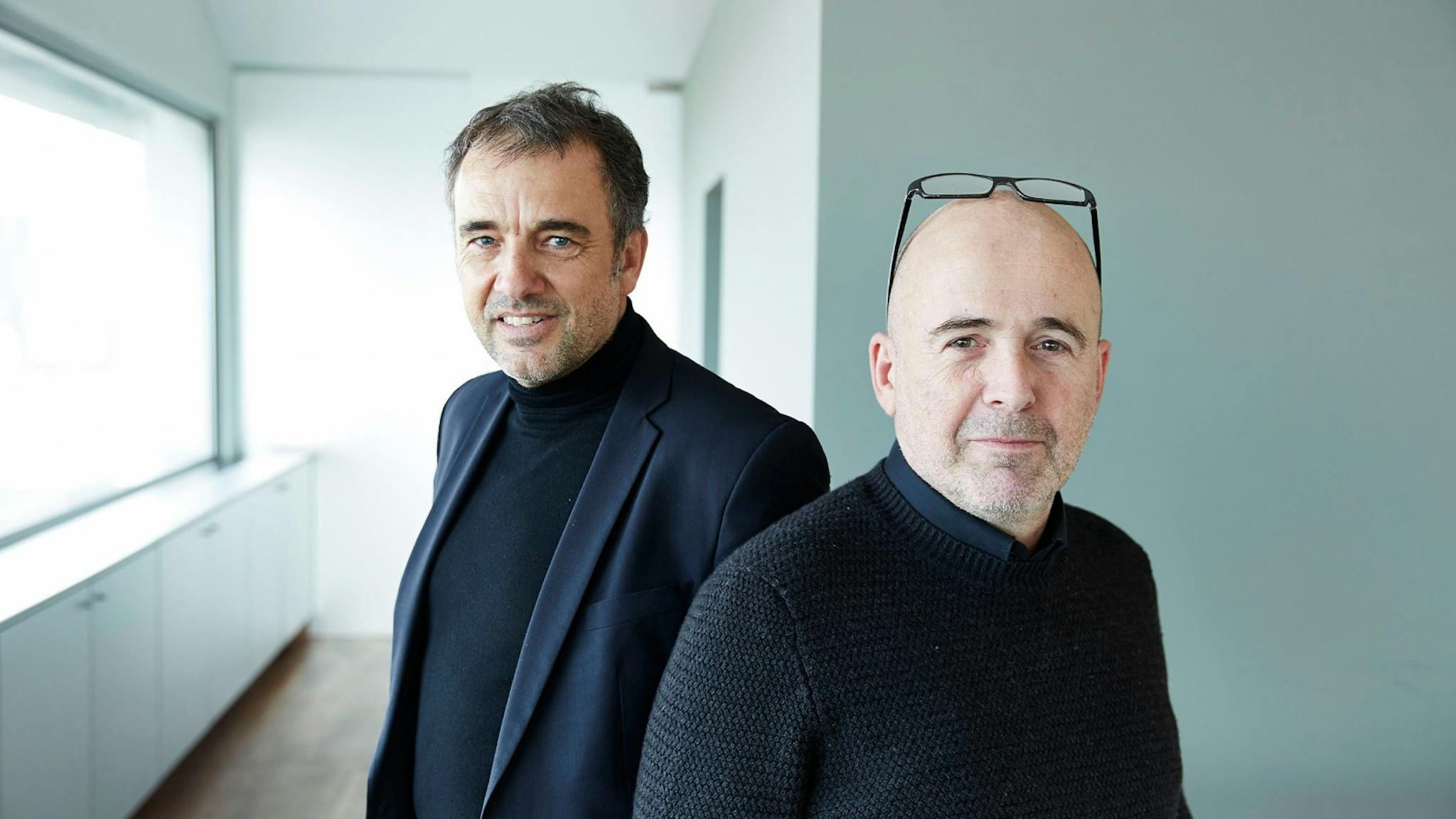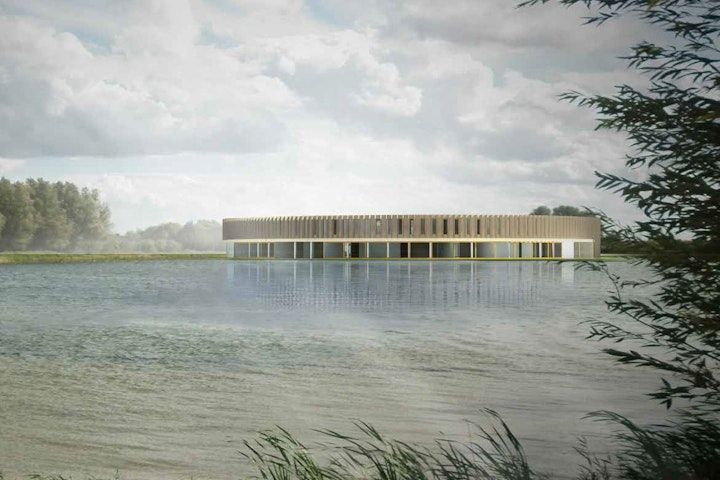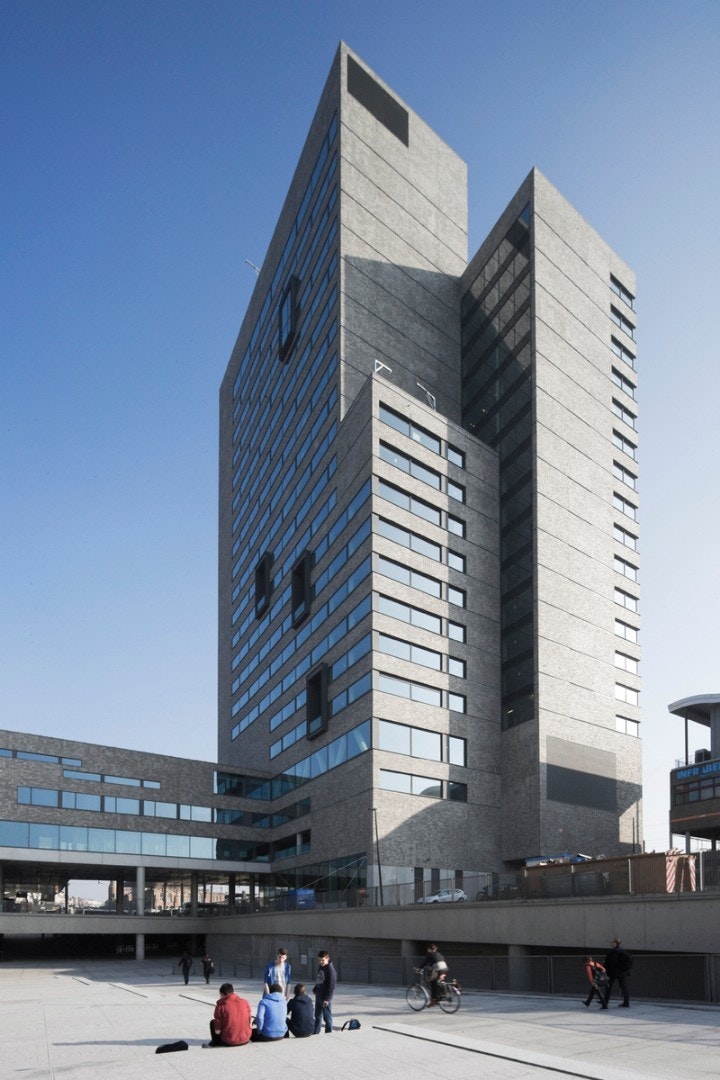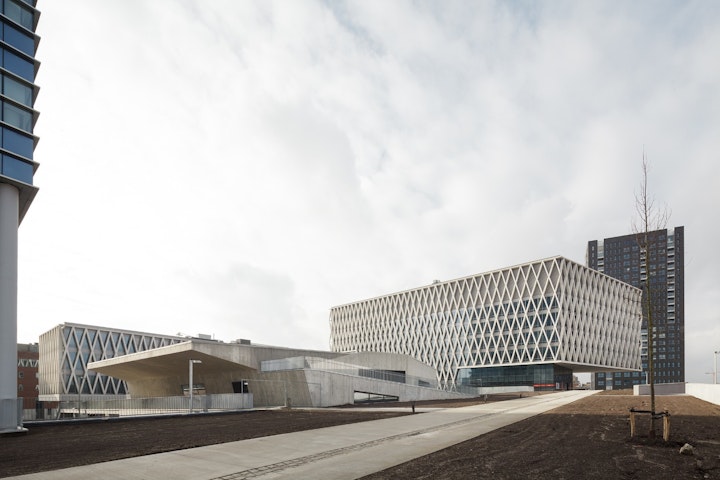Interview with POLO Architects
“Complex challenges really fit us to a T.”
Patrick Lootens, co-founder of architect studio POLO Architects

Patrick Lootens & Mauro Poponcini © Frank Peterschroeder

Red Cross care hotel
The scene: early nineties, when a chance encounter in the street between Patrick Lootens and Mauro Poponcini heralded the beginning of a very beautiful story.
The start of POLO
The conversation did not last long, but it did cause the two former fellow students in civil engineering-architect at the Catholic University of Leuven to register for the architecture competition for the exhibition pavilion for Belgium in Seville in 1992.
They would not win, but the ambitious duo did leave. Started in 1991 together with another trainee, some 25 years later they now work with a staff of 60 and form one of the most imaginative architectural offices in our country. Time for a good conversation with the ‘LO’ from ‘POLO’.
How did your passion for architecture come about?
‘I have always had well-developed antennae for my surroundings. A kind of sensitivity… Architecture has to do with space. It wasn’t that I suddenly thought I wanted to be an architect when I was twelve. It developed very gradually. I had studied Latin and mathematics in my secondary school. Normally you become a civil engineer, but I wanted to put my artistic urge into action somewhere.’
‘During my time in Leuven, my affinity was also more with architecture than with engineering. I never worked as an engineer either. After my studies, I was tempted to go abroad. I went to Campeche in southern Mexico for two years, where I worked as a caretaker of monuments. After that, I immediately started working as a self-employed person in Belgium. First I worked for agencies as a freelancer, then I started with my own projects.’
What were the key moments in your career?
‘Quite early on, I won an award, the Charles Wilford Architecture Prize. That was for a small house in Schoten that cost only 3 million Belgian francs. That was an enormous boost for me. At that moment, you know you are on the right track. The meeting with Mauro in the early 90s was of course crucial. The click was made and Poponcini & Lootens was born.’
‘In the beginning we mainly designed villas and houses. But in 1994 we were invited to participate in a competition for the Belgacom regional headquarters in Hasselt. We competed against all the big names at the time and eventually won after a very intense battle. It was a building of around 30,000 square metres. We received very favourable reviews. However, the project was never realised.’
‘The same story happened in ’95 for the Bekaert headquarters and in ’96 for the Seghers Group. Each time, we won the competitions, but the projects were never realised. It was not until 2001, with the new site for the faculty of dentistry and pharmacy at Gasthuisberg in Leuven, that a victory in an important competition resulted in actual realisation for the first time.’
‘At that time, competitions were gaining in importance. There were almost none. The late Jo Crepain was a great advocate of this. In this way, young architects were given the opportunity to realise beautiful things. A tradition that is continued to this day. Unfortunately, it is a system that is under pressure nowadays.’

Flemish Administrative Centre (Ghent) © Sarah Blee
How come?
You see, first there’s a selection. If you pass that selection, you get a fixed amount of money to make a competition design. I’m just saying, €5,000 for example. But the energy you put into it costs a lot more, perhaps €40,000. Moreover, competition has become much fiercer these days. In Flanders, the quality of architecture in general has risen sharply, a favourable trend.
What makes POLO different from other architectural firms?
Every architect has his own personality, something that’s characteristic. We have the combination of our academic attitude and training on the one hand, and our pragmatic and realistic attitude on the other. We don’t build castles in the air. Mauro still teaches at the KU Leuven and I did so for 13 years at the Henry Van de Velde Institute in Antwerp.
At one point, out of a personal interest in a broader social context, I exchanged my teaching assignment for a Master after Master at KU Leuven in ‘Urbanism & Strategic Planning’. Urbanism and spatial planning is very decisive for the way we live. This is also something I have grown into, and it plays an increasingly important role in the development of POLO.
Imagine: you get ‘carte blanche’ to rebuild Antwerp or another important city from scratch. What would it look like?
The big ‘master plan’ does not exist. You cannot come up with the solution like a ‘deus ex machina’. The moment a master plan is implemented, you usually have to start all over again because reality catches up with you. That is why strategy is so important. You have to learn to deal with uncertainties and combine sustainability with flexibility. History is an important tool in this respect, to make a reading of the future…
“To be a good urban planner, you have to know and feel the sensitivities of a society. The principle of sustainability is important here. As architects, we play an important role in this, and let’s be honest: ‘beautiful’ or ‘ugly’ only have a limited influence.”

Artesis Plantijn University College (Antwerp) © Stijn Bollaert
How do you see architecture evolving in the future?
‘Perhaps I should start by setting a critical note. Today, there is a pronounced trend – on a global scale, that is – towards visual culture, and the iconic content of star architects is almost praised to the stratosphere. It’s a pure branding machine. I have serious questions about this trend. It’s a balloon that will hopefully be punctured soon.’
‘In this way, architecture becomes a caricature of itself. That’s not the path I want to go down. An example is the Guggenheim Museum in Bilbao by North American architect Frank Gehry. It is rehearsed all over the place, like in Berlin, for example. It’s a hollow box and it does not meet the basic values that architecture should fulfil. I prefer an architecture that keeps the residents and the environment in focus.’
How do you see the future for POLO, what ambitions do you have?
‘It is undoubtedly time for a broadening, more in line with the current context, with a greatly increased technicality and complexity inherent in today’s social issues. Our work will be more horizontal than it is today. Research will play a major role in this. Our role as mentor, guiding a talented team, will become increasingly important. We want to evolve further towards an open and transparent working atmosphere within a team of specialists. 50 years is still a fairly young age for an architect, so the ambition remains high.’
Who influences you at present and who has played an important role for you in the past?
‘At the moment, I am mentally trying to distance myself from influences and trends, and I am trying to fold back to my own identity as much as possible. Yet you can never completely detach yourself from this. That was also the case in the past. As a starting architect, I considered some somewhat misunderstood modernists as my teachers, Paul Neefs, Georges Baines and later Bob Van Reeth, but he doesn’t know that (laughs).’

LUCA School of Arts (Brussels) © Toon Grobet
What’s your favourite building?
‘Bob Van Reeth’s Dossin Barracks in Mechelen, which now houses the Holocaust Museum, struck me recently. Abroad, the visit to Luis Barragàn’s home in Mexico City remains a lasting reference.’
What is the best compliment you have ever received?
‘Actually, it’s every time a customer says a heartfelt ‘thank you’ for a beautiful design. Therein lies the essence.’
Which projects do you prefer?
‘Mainly projects with a high degree of complexity. In difficult projects, we can make the difference and we feel like a fish in the water. This is where our added value lies. This is due to our different competences, but also to our eagerness to learn. We are hard workers. That sometimes takes time and research, but that is what motivates us. The financial picture is not always the most important thing for us, even though we are obliged to remain a healthy company.’
Which project has given you the most satisfaction?
‘That is not an easy question, but the art school St.-Lucas in Schaarbeek certainly is one of them. When you see and feel that the students like being there and feel at ease, it gives a lot of satisfaction and energy.’
“We always have very diverse types of assignments.”
Have you been working with Serge Hannecart and I Love Life for a long time?
‘We have known Serge for a long time and have done several projects with him since 1996. What we have always appreciated in the cooperation is the creative approach that he always wanted to follow. There has always been a creative ‘vibe’, even in the early days with Himmos in the development of the Kaai in Antwerp, and often against the current. And so it is again with ‘Cabo Verde’, where we are working together on what is to become the most beautiful project in Cape Verde.’
‘The holiday resort will be beautifully integrated into the landscape with respect for the environment. The rocks will literally be removed from the ground so that the buildings will fit seamlessly into the surroundings. It’s truly a poetic place. Speaking of fulfilment… For me personally, it’s also a nod to my ‘sunny’ period in southern Mexico, and so the circle is complete.’
Written by
Veerle Symoens
